| Bringing Vintage Aircraft to Life since 2010 |
|
|
 |
|
|
|
Roy Chadwick's Lancaster would spend fifteen years in service with the Royal Air Force, and is, perhaps, best known for its role in the Dambusters raid in May 1943, which was led by Wing Commander Guy Gibson. As well as serving with Bomber Command during the Second World War it would also be used as a civil airliner. This article details 25 Avro Lancaster facts, from its entry into service until its retirement by the RAF. Designed by Roy ChadwickRoy Chadwick was born on the 30th April 1893 in Farnworth, Lancashire and joined Avro in September 1911 as a draughtsman at the age of 18. He would become the company's chief designer seven years later in 1918. A number of aircraft designed by Roy Chadwick would be used during the Second World War, such as the Avro Anson, but it is the Avro Lancaster which is perhaps the most well known. At the age of 54 Roy Chadwick died when the Avro Tudor prototype he was on crashed on take-off on the 23rd August 1947. Derived from the Avro Manchester The twin-engined Avro Manchester suffered mainly due to its Rolls-Royce Vulture engines, which were unreliable and unable to reach their optimal performance. So before the aircraft had performed its first operational sortie, the 4th November 1940 saw Avro given the green light to work on what was known as the Manchester Mk III by the Air Ministry. This would have a wingspan 10 ft 2 in longer than the Manchester and was powered by four Rolls-Royce Merlins. It was this aircraft that would be developed into the Lancaster. 10,500 Individual Drawings During the production of the Lancaster around 10,500 individual drawings were needed and each aircraft required approximately 10 tonnes of light aluminium alloy. Cost of a Lancaster On average a Lancaster, minus its armament, bomb sight, radio and radar equipment, cost, at the time, £59,000, which included its four engines. Crew of Seven The Lancaster typically had a crew of seven, made up of pilot, bomb-aimer, flight engineer, navigator, wireless operator, mid gunner and rear gunner. 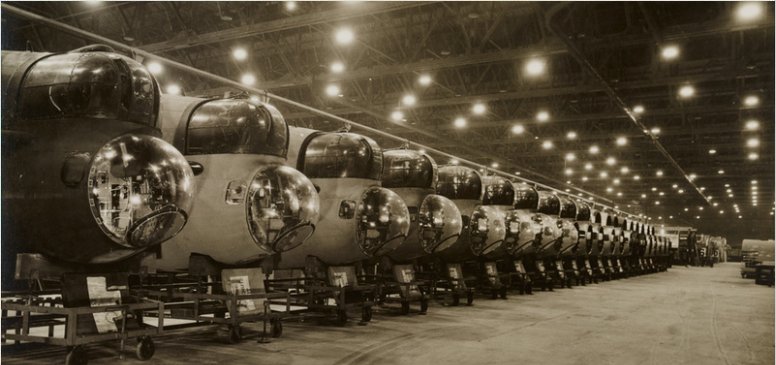
Lancaster fuselage assembly at Castle Bromwich | Photo by Birmingham Museums Trust, licensed under CC0
First Flight The first Lancaster prototype (BT308) flew on the 9th January 1941 from Ringway Airport. Captain Harry Brown and Sydney Thorn were at the controls. This featured an increased wingspan over the Manchester and a central fin on the tail, which was removed on the second prototype. Entry into Service It would be with No. 44 Squadron, based at RAF Waddington that the Lancaster would first enter Royal Air Force service, when they took delivery of their first three aircraft on the 24th December 1941. These would replace their twin-engined Handley Page Hampdens. First Operational Sortie No. 44 Squadron would perform the Lancaster's first operational sortie, which took place on the 3rd March 1942. This saw four aircraft lay mines in the Heligoland Bight. Bristol Hercules Powered Lancaster B.II Of the Lancaster variants produced all would be powered by either Rolls-Royce or Packard Merlins, the exception was the Lancaster B.II, which was powered by the 1,735-hp Bristol Hercules XVI engine. It was 10 mph slower than the Merlin powered Lancasters, with a top speed of 205 mph, its service ceiling was 18,500 ft, which was 6,000 ft lower. Only 301 Lancaster B.IIs were built. Basis for the Avro York Another Roy Chadwick design, the Avro York was a transport aircraft that featured the wings, tail and landing gear of the Lancaster, fitted to a new fuselage. The aircraft would be used by Transport Command and the British Overseas Airways Corporation. 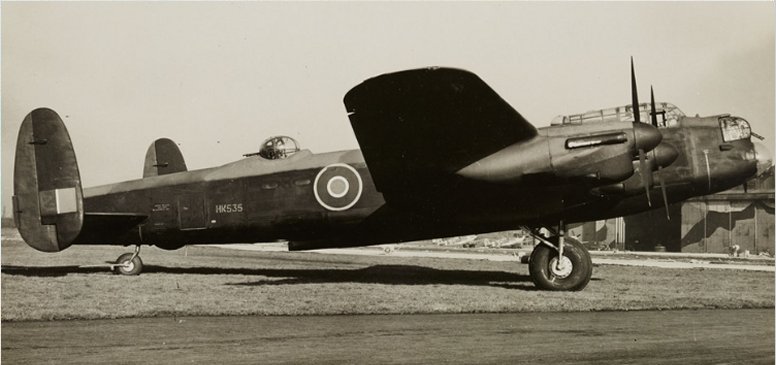
Lancaster B.I (HK535) | Photo by Birmingham Museums Trust, licensed under CC0
Flew Under Sydney Harbour Bridge During 1943 Lancaster B.III (ED930) Q for Queenie embarked on a promotional tour of Australia to sell war savings bonds. With Flight Lieutenant Peter Isaacson at the controls, the 22nd October 1943 saw hm fly the aircraft under Sydney Harbour Bridge. 'Clapper Kites' Some Lancaster B.Is would have their front and mid-upper turrets removed and some interior items removed. Powered by Rolls-Royce Merlin 24 engines, they were renamed to Lancaster B.I (Special). Due to their high speed without a bomb load they were nicknamed 'Clapper Kites'. Lancaster Test Beds A number of Lancasters would be used as test beds or for research, this included Lancaster B.II (LL735) which was used to test the Metropolitan-Vickers F2 turbojet. Fitted towards the rear of the fuselage, with the exhaust where the rear turret would've been. Very Long Range Lancaster To increase the range of the aircraft, for potential operations in the Pacific, a pair of Lancaster B.Is (HK541) and (SW244) would have a 'saddle tank' installed. This was fitted behind the cockpit and extended down past the wings, increasing fuel capacity by 50%. Operation Exodus Beginning on the 3rd April 1945 until the 31st May 1945, Operation Exodus saw many prisoners of war flown home by a number of aircraft, including the Lancaster, which with modifications could transport 20 to 24 people. 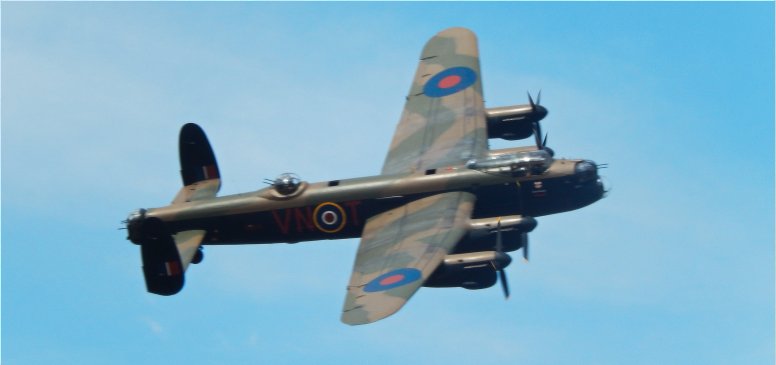
Lancaster B.I of the Royal Air Force Battle of Britain Memorial Flight
Equipped at least 59 Squadrons During its service in the Second World War the Lancaster would equip at least 59 frontline Bomber Command squadrons. Lancaster Users As well as the Royal Air Force a number of other countries used the Lancaster, including the Royal Australian Air Force, Royal Canadian Air Force and Royal New Zealand Air Force. Ten Victoria Cross Winners Ten Lancaster aircrew would be awarded the Victoria Cross during the Second World War. The first was awarded to Squadron Leader John Nettleton as a result of his actions with No. 44 Squadron flying Lancaster B.I (R5508) during a daylight attack on Augsburg, Germany on the 17th April 1942 (read the citation). With Captain Edwin Swales DFC of No. 582 Squadron the last, after being posthumously awarded the Victoria Cross for his actions flying Lancaster B.III (PB538) when acting as a Master Bomber when Pforzheim, Germany was raided on the 23rd February 1945 (read the citation). Total Built In total 7,377 Lancasters were built during its production run between 1941 and 1946. The last example, a Lancaster B.I, was built on the 2nd February 1946. A number of companies apart from Avro were also involved in the production of the aircraft, including Austin Motors Limited and Victory Aircraft Limited based in Canada. Ton Up Lancs On average the number of operational sorties flown by a Lancaster was 21. However, 35 aircraft would take part in 100 sorties or more during the Second World War. One of these was Lancaster B.I (R5868) S for Sugar which completed 137 sorties whilst with No. 83 Squadron and No. 467 Squadron, Royal Australian Air Force. May 1944 saw it reach the 100 sortie milestone, with a raid on Flensburg Harbour, Germany on the 23rd April 1945 seeing the aircraft performing its last operational sortie. This aircraft is on display at the Royal Air Force Museum, London. 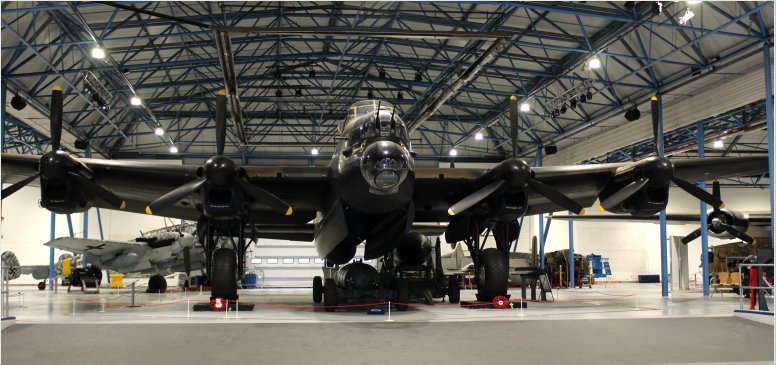
Lancaster B.I (R5868) S for Sugar at the Royal Air Force Museum, London
'Tiger Force' After the war in Europe ended on the 8th May 1945, it was intended to send a number of Lancaster squadrons to the Pacific. This would be known as the 'Tiger Force' and was to attack targets in Japan in the lead up to invasion, known as Operation Downfall. However, Japan surrendered before the force could be fully established. Goodwill Tour No. 35 Squadron were chosen to undertake a five week goodwill tour of the United States during July and August 1946. They would visit a number of airfields in the country. Developed into the Avro Lincoln As development of the Lancaster continued, a high altitude version featuring an increased wingspan and fuselage was produced, known as the Lancaster B.IV. However, with so many changes it was renamed the Avro Lincoln I, with the Lancaster B.V known as the Lincoln II. Avro Lancastrian The Lancastrian was a civil version of the Lancaster able to carry a small number of passengers and mail. Early Lancastrians were converted Lancasters with later aircraft built as Lancastrians from the start. Changes to the aircraft included the removal of its armament and armour. It would be used by a number of airlines, including British Overseas Airways Corporation. 15 Years Service with the Royal Air Force The Lancaster's time with the Royal Air Force came to an end on the 15th October 1956 when the School of Maritime Reconnaissance retired their Lancaster MR 3, ending 15 years service with the RAF. 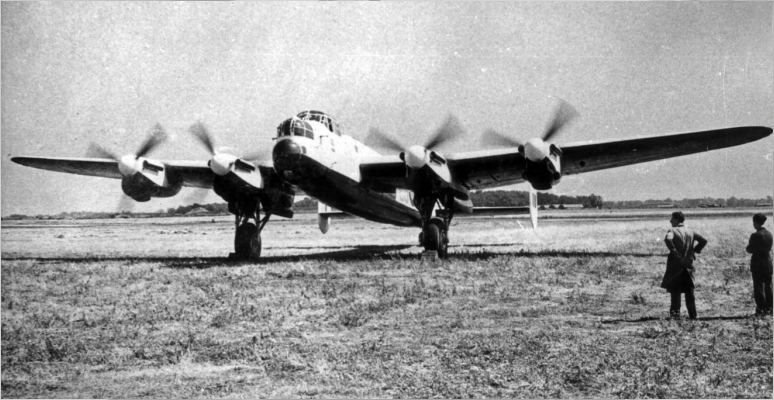
Avro Lancaster in the white and black camouflage scheme of the 'Tiger Force' © Wingleader Archive
< Back to articles |
|
|
|
||||||||||||||
|